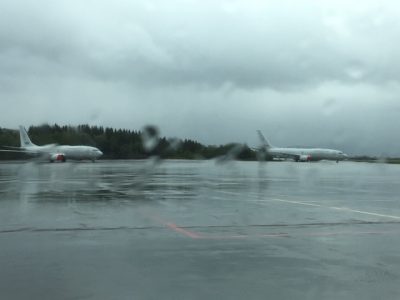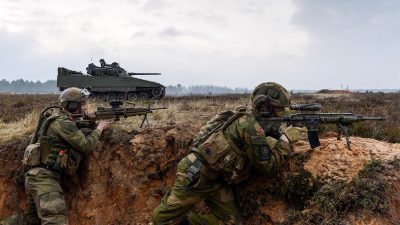NEWS ANALYSIS: Nordic strengthening of the NATO alliance won’t come a moment too soon for Norway. Russia’s invasion of Ukraine has already challenged much of the defense policy behind Norwegian governments for years, exposed an urgent need for stronger defense capability nationwide, and for major changes in defense priorities.

The Norwegian government, backed by an overwhelming majority in Parliament, welcomes and firmly supports the NATO membership applications from Sweden and Finland, which won a green light at the NATO Summit in Madrid last week. Both countries had also seen a sudden need to radically change their own defense policies right after Russian President Vladimir Putin started attacking Ukraine last winter.
Norwegian Prime Minister Jonas Gahr Støre has repeatedly claimed that the entire Nordic area will benefit from closer defense ties with Sweden and Finland, and be stronger together. Norway, a founding member of NATO, has always claimed to be “the eyes and ears” of the defense alliance in the north, keeping a watchful eye on Soviet- and later Russian action in the area. Many Norwegians have also tried hard to stay on good terms with its large northern neighbour, and been driven by an overall feeling that Europe would continue to enjoy lasting peace after the horrors of World War II. Foreign Minister Anniken Huitfeldt also referred to the centuries of cooperation with Russia and the Soviet Union just before Putin’s invasion.
That was all but shattered when Putin invaded Ukraine on February 24. Now Norway, like most all other Nordic and European countries, is having to come to grips with a harsh new reality, and a creeping realization that Putin’s war is likely to drag on for a long time. Since his troops failed to quickly seize Kyiv and overpower Ukrainian defense forces, some think his war may turn into a sort of endurance contest.
It’s all been the ultimate wake-up call for a succession of Norwegian government leaders who’ve all emphasized dialogue and cooperation with Russia and seemed certain that the end of the Cold War marked the beginning of a new era of peace and prosperity. NATO also wanted to cooperate with the “new” Russia in a wide variety of areas, although Putin thinks differently and has felt threatened himself by NATO’s earlier expansion into former Soviet countries. Norwegian officials nonetheless managed to keep working with their Russian counterparts on Arctic fishing issues, search and rescue operations and even famously divvying up the Barents Sea between them.

Two defense and foreign policy experts at Utsyn, a Norwegian organization concentrating on both areas, noted in newspaper Aftenposten recently that Norway not only believed in lasting peace in Europe but also that if a war should break out, Norway’s defense responsibilities would probably be limited to its northern regions, specifically Finnmark, and involve only military activity.
Now, claim Hedda Langemyr and Terje Bruøygard of Utsyn, Norwegian officials have to recognize that peace in Europe has been shattered, that any war directly involving Norway would affect the entire country, and that it won’t only play out on traditional battlefields. Putin’s war on Ukraine has already led to sanctions, economic pressure, import restrictions, transport disruption, an energy crisis and looming food shortages, in addition to turning hundreds of thousands of Ukrainians into refugees. And then there’s the threat of cyber warfare, which Norway got a taste of in the midst of the NATO Summit last week when a Russian hacker group took credit for disrupting several government and media websites.
Area around Oslo vulnerable
Norway and most of its allies seemed to keep hoping for the best even after Russia attacked Georgia in 2008 and felt entitled to annex Ukraine’s Crimean Peninsula in 2014. Norway’s new Labour-Center government that took office last fall remained optimistic about the prospects for improving cooperation with Russia. “It wasn’t a mistake for NATO or Norway to continue the diplomatic dialogue with Russia,” wrote Langemyr and Bruøygard, but such hopes “overshadowed clear signals that Russia was moving in the opposite direction.” Despite all the intelligence showing how Russian troops were gathering at the border to Ukraine, and all the warnings from Washington, few believed Putin would actually order an attack. “It was simply not possible to see, with western eyes, what strategic goals he could achieve,” they wrote.
Putin’s ruthlessness, with a new round of attacks on civilians this week, has fired up Norwegian defense but perhaps not enough. “Europe is no longer in deep peace,” wrote the Utsyn experts. “It’s hard to see a full victory for either side … or a peace treaty that both could be accepted.” They fear a “frozen conflict over time,” and believe that Europe is forever changed. That’s also further boosting defense needs.

Russia’s warfare in Ukraine, for example, has shown that they’ve aimed to affect the entire country, commit atrocities in small villages and suburbs of Ukraine and even bomb targets close to the Polish border. Their blockade of Mariupol in the south showed no mercy for children, the elderly or other vulnerable civilians. Norwegians can thus no longer think a direct conflict with Russia would be contained to Finnmark in the north. Norway is currently readying military bases in the north to receive NATO troops obligated to come to Norway’s aid, but just as much help may be needed far to the south and in between.
“There’s good reason to believe that if we were to land in a war with Russia, our own heavily populated areas in and around Oslo along with critical harbours and airports in the south would be targets of a Russian attack,” wrote Langemyr and Bruøygard. That calls for a new debate on the size, structure and placement of Norwegian military defense, they contend: “It’s no secret that we have a capital that lacks anti-aircraft defense, and that strategic transport connections are protected only by a home guard (Heimevern) without means of fending off modern threats like drones, air raids and missiles.”
They paint a chilling picture of Norway’s ongoing lack of preparedness despite its membership in NATO. Other Norwegian commentators have noted in local media how the newer NATO members Estonia, Latvia and Lithuania fear “coup-like” attacks in their own countries by local Russian minorities. That could give Russia an excuse to invade to “save” their fellow Russians, and raises questions whether NATO allies would be able to come to their defense quickly enough. They received some reassurance at last week’s NATO summit, with the alliance’s new “Strategic Concept” for the years ahead including a strengthening of NATO’s eastern flank along the Rusian border. There will be more joint exercises and placement of NATO troops along the Russian border.
Sverre Strandhagen, who’s followed defense issues for newspaper Dagens Næringsliv (DN), wrote last week how some NATO officials see a need for more brigades within NATO’s eastern member countries, while others still don’t think Putin will risk triggering a war with NATO itself that they’d be “doomed” to lose. NATO members must rely on NATO’s ability to respond if any member is attacked.

Norway has recently extended its own troop deployment to Lithuania, and also plans to take part in military exercises along with US troops in Finland later this month. They’re not wasting any time in developing Nordic military cooperation. Norwegian military leaders also defend their own defense capability at home, pointing to their own armed forces, NATO and an allied network. “Those of us in the military are doing our best to secure that peace, freedom and democracy will be the values future generations can enjoy,” Lt Gen Yngve Odlo, chief of the Norwegian armed forces’ operative headquarters, wrote in DN earlier this month.
DN itself, meanwhile, editorialized how it was “embarrassing” for Prime Minister Støre to concede at last week’s NATO summit that Norway will not meet NATO’s own goal for member countries to spend at least 2 percent of GNP on defense. Norway’s GNP is so large, mostly because of higher oil and gas prices ironically fueled buy Putin’s war on Ukraine, that even increased Norwegian defense spending will only amount to 1.55 percent of GNP this year.
It means Norway will land among the five “worst” NATO members unable or unwilling to meet the 2 percent goal: Canada, Luxembourg, Portugal and Slovenia. DN noted that other members meeting the defense spending goal aren’t likely to show much sympathy, not least when they have much bigger economic problems than Norway, where the economy has continued to boom. The message is clear: Norway needs to continue building up its own national defense, in addition to relying on NATO’s assistance.
newsinenglish.no/Nina Berglund

